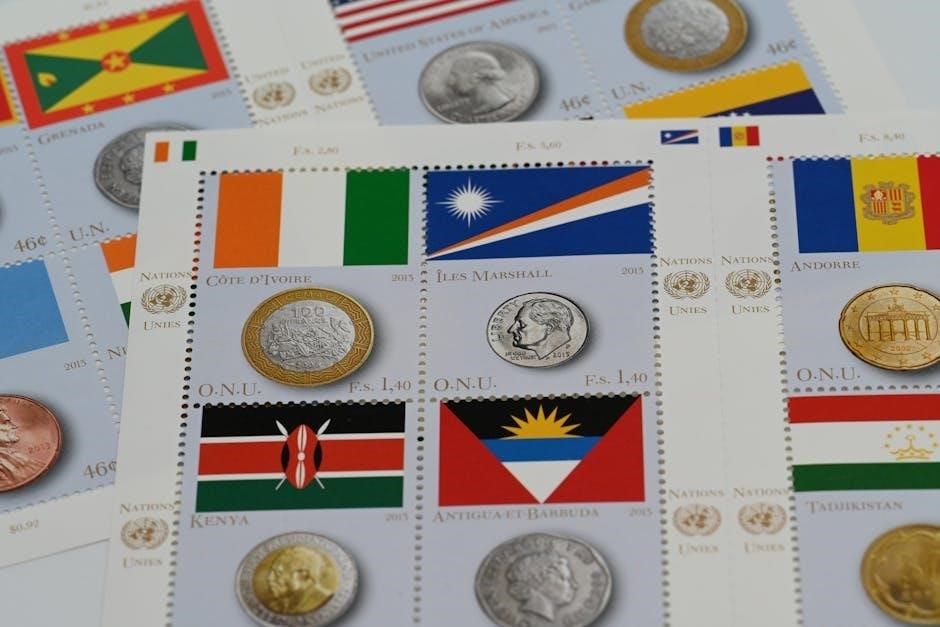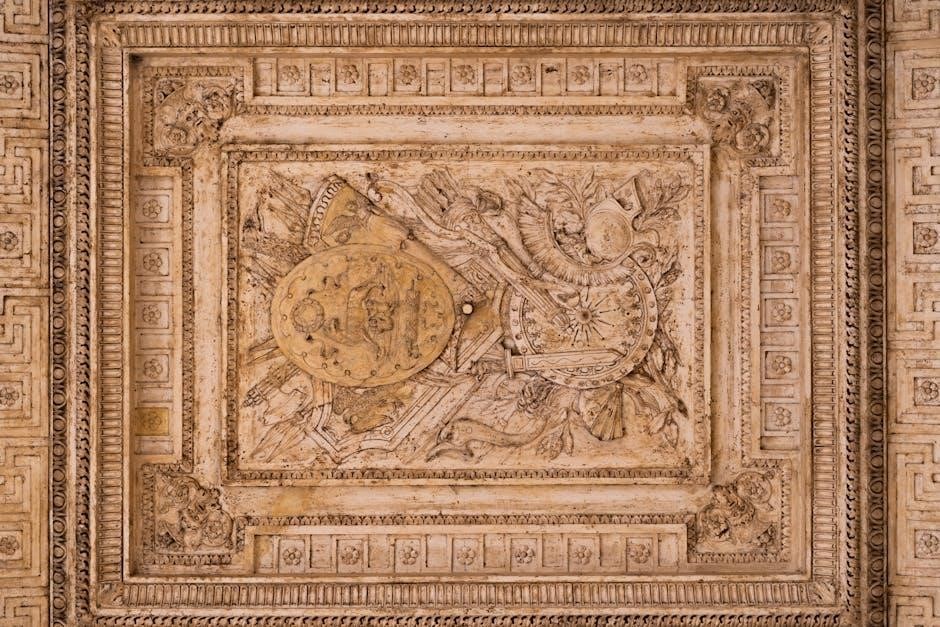
ap world history exam pdf
The AP World History Exam is a standardized test offered by the College Board, covering 10,000 years of global history. It assesses knowledge from the Paleolithic Era to modern times, emphasizing historical themes, concepts, and skills. High school students can earn college credit by performing well, making it a key opportunity for academic advancement.
Overview of the College Board and the AP Program
The College Board is a non-profit organization founded in 1900, dedicated to expanding access to higher education. It connects students to college success through programs like the Advanced Placement (AP) Program, which offers college-level courses and exams. Over 6,000 leading educational institutions are part of its membership. The AP Program allows high school students to earn college credit by taking challenging courses and performing well on standardized exams. The College Board also provides resources like AP Central and official study materials to support student preparation. Its mission is to equitably enable students to achieve their academic and career goals.
Importance of the AP World History Exam for College Credit
The AP World History Exam provides students with the opportunity to earn college credit while still in high school, significantly reducing their future course loads and tuition costs. By performing well on the exam, students demonstrate mastery of college-level coursework, which is recognized by most four-year colleges and universities. This exam is a cornerstone of the AP Program, as it bridges high school and higher education, preparing students for academic success. Earning credit through AP exams also allows students to pursue more advanced courses or explore diverse fields earlier in their college careers. The College Board ensures that the exam aligns with college-level standards, making it a trusted pathway to academic advancement.

Structure of the AP World History Exam
The AP World History Exam is 3 hours and 15 minutes, featuring multiple-choice, short-answer, and free-response sections divided into two parts each, with specific time allocations.
Section I: Multiple-Choice and Short-Answer Questions
Section I of the AP World History Exam is 95 minutes long and consists of two parts: 40 multiple-choice questions and 3 short-answer questions. The multiple-choice section assesses knowledge of key historical concepts, events, and themes, while the short-answer questions require concise, well-supported responses. Students must answer all multiple-choice questions and complete three short-answer prompts, with one being optional. Both question types emphasize the ability to analyze historical evidence, identify patterns, and apply thematic skills. The section evaluates understanding of global processes and interactions across different time periods. Effective time management is crucial, as the format demands both speed and accuracy to score well.
Section II: Free-Response Questions
Section II of the AP World History Exam is a 100-minute free-response section, divided into two parts. Part A includes a document-based question (DBQ) requiring analysis of historical sources and thematic connections. Part B consists of two essay questions, each focusing on a specific historical theme or period. Essays must demonstrate clear arguments, evidence-based reasoning, and historical context. The section assesses critical thinking, writing skills, and the ability to synthesize information. Scoring is based on rubrics evaluating thesis development, evidence use, and contextual understanding. Practice with sample questions and rubrics is essential for success in this section, as it demands both analytical depth and effective writing.
Time Allocation and Exam Duration
The AP World History Exam is 3 hours and 15 minutes long, divided into two sections. Section I, lasting 95 minutes, includes multiple-choice and short-answer questions. Section II, lasting 100 minutes, focuses on free-response questions, including the document-based question (DBQ) and two essay prompts. The DBQ is allocated 60 minutes, while the two essays share the remaining 40 minutes. Students must manage their time effectively to complete all parts of the exam. Proper time allocation is crucial for addressing each question thoroughly, especially in the free-response section, where detailed essays require careful planning and execution. Practice with timed sections can help students optimize their performance.

Key Components of the AP World History Course
The AP World History course covers 10,000 years of global history, emphasizing themes like human-environment interaction, civilizations, and global networks. It develops critical thinking and evidence-based reasoning skills.
Course Framework and Learning Objectives
The AP World History course framework is designed to help students understand global historical processes and connections. It spans 10,000 years, from the Paleolithic Era to the present, focusing on nine distinct historical periods. The framework emphasizes key themes, including human-environment interaction, cultures, and global networks. Students develop critical thinking, evidence-based reasoning, and historical contextualization skills. The course encourages the analysis of historical evidence, such as primary sources and data, to construct well-supported arguments. By mastering these objectives, students prepare for college-level history coursework and cultivate a deeper understanding of global dynamics. The framework ensures a balanced approach to historical inquiry, fostering intellectual curiosity and academic rigor.
Historical Periods Covered in the Course
The AP World History course spans nine distinct historical periods, beginning with the Paleolithic Era and concluding with the modern world. Each period is carefully defined to provide a comprehensive understanding of global development. From the rise of civilizations in Mesopotamia, Egypt, and the Indus Valley to the complexities of the Cold War and contemporary issues, the course offers a chronological and thematic exploration. Students analyze the evolution of societies, cultures, and technologies, tracing patterns of continuity and change. This extensive timeline ensures a broad yet detailed study of human history, equipping students with a robust foundation for advanced historical analysis and critical thinking. The course’s structure allows for an in-depth examination of each era, fostering a nuanced understanding of global interconnectedness.
Themes and Skills Assessed in the Exam
The AP World History Exam evaluates students’ understanding of five key themes: human-environmental interaction, social and cultural development, political structures and governance, economic systems and exchange, and technological and scientific advancements. Additionally, the exam assesses critical skills such as historical thinking, contextualization, and evidence-based argumentation. Students must demonstrate their ability to analyze primary and secondary sources, synthesize information, and construct well-supported essays. The exam also tests chronological reasoning and the ability to connect historical events across different regions and time periods. These themes and skills are central to the course framework and are essential for success on the exam.

Preparing for the AP World History Exam
The AP World History Exam preparation involves using the Course and Exam Description (CED), official practice exams, and study guides for focused review and skill improvement.

Official Study Materials and Resources
The College Board provides the AP World History: Modern Course and Exam Description (CED), a comprehensive guide outlining course framework and exam structure. This document includes sample questions, scoring guidelines, and content focus, ensuring students align their study with exam expectations. Additionally, official practice exams and past papers are available, offering hands-on experience with question formats and timing. Students can access free-response questions, scoring rubrics, and sample responses through the AP Central website. These resources are essential for targeted preparation, helping students identify strengths and areas needing improvement. Utilizing these materials ensures a well-rounded understanding of the exam’s requirements and enhances readiness for test day.
Practice Exams and Sample Questions
Official AP World History practice exams and sample questions are invaluable for exam preparation. The College Board offers full-length practice tests, including multiple-choice and free-response sections, mirroring the actual exam format. These resources allow students to familiarize themselves with question types, timing, and content distribution. Past exams are available online, enabling targeted revision based on identified weaknesses. Additionally, sample questions from recent years provide insights into emerging trends and focus areas. By utilizing these materials, students can refine their test-taking strategies, improve time management, and build confidence. The AP World History: Modern Course and Exam Description (CED) further complements these resources, offering contextual guidance for effective preparation.
Strategies for Mastering Multiple-Choice Questions
Mastering multiple-choice questions on the AP World History Exam requires a strategic approach. Begin by thoroughly understanding the exam format and content, as outlined in the AP World History: Modern Course and Exam Description (CED). Skim through questions to identify key terms and contextual clues, then eliminate incorrect options using the process of elimination. Prioritize questions you feel most confident about to manage time effectively. Additionally, focus on recognizing recurring themes and patterns in historical events, as these often appear in multiple-choice questions. Regular practice with official sample questions and past exams will enhance familiarity with question structures and improve accuracy. Reviewing answer explanations after practice exams is crucial for identifying and addressing knowledge gaps. Stay calm, manage time wisely, and avoid overthinking to maximize performance.
Techniques for Writing Effective Free-Response Essays
Writing effective free-response essays for the AP World History Exam demands a clear and structured approach. Begin by carefully reading the question and identifying all components of the prompt. Develop a concise thesis statement that addresses every part of the question. Organize your essay with an introduction, body paragraphs, and a conclusion. Each paragraph should focus on a specific argument, supported by relevant historical evidence and examples. Use chronological or thematic analysis to maintain coherence. Practice outlining essays within the 40-minute time frame to improve efficiency. Reviewing sample essays and scoring guidelines from past exams will help you understand how to meet the College Board’s expectations. Ensure your writing is clear, concise, and directly addresses the question to earn the highest scores. Regular practice and feedback are essential for refinement.

Scoring and Evaluation of the AP Exam
The AP World History Exam is scored on a 1-5 scale. Multiple-choice and free-response sections are graded separately, with scores combined to determine the final result.
How the Exam is Graded
The AP World History Exam grading process involves a combination of machine scoring for multiple-choice questions and human graders for free-response sections. Each section is weighted, with Section I (multiple-choice and short-answer) contributing 60% and Section II (free-response essays) contributing 40%. Graders use detailed rubrics to assess essays, ensuring consistency and fairness. Raw scores are converted to the 1-5 scale using statistical methods, with 3 considered passing. The College Board ensures scoring accuracy through rigorous training and monitoring of graders, maintaining the exam’s integrity and reliability.
Scoring Guidelines and Rubrics
The AP World History Exam uses detailed scoring guidelines and rubrics to ensure consistency in grading. These tools are developed by the College Board to evaluate student responses accurately. For free-response questions, rubrics assess historical thinking skills like contextualization, evidence, and synthesis. Each question has specific criteria, and graders are trained to apply these standards uniformly. The College Board provides sample scored responses and scoring distributions to help students and educators understand expectations. By reviewing these resources, students can better prepare for the exam and improve their performance. The rubrics are publicly available in the AP World History: Modern Course and Exam Description and on the College Board’s website.
Understanding Scoring Distributions
The scoring distributions for the AP World History Exam reveal how students perform collectively on each section and question. These distributions are released annually by the College Board and provide insights into the difficulty of specific questions and overall exam performance. By analyzing these distributions, students and educators can better understand the exam’s challenges and set realistic expectations. The distributions are determined by the performance of thousands of students and are aligned with the scoring guidelines and rubrics. They are available on the College Board website and in the AP World History: Modern Course and Exam Description document. This data helps students identify areas for improvement and educators refine their teaching strategies.

Exam Day Preparation and Tips
On exam day, arrive early, bring all necessary materials, and manage your time wisely. Stay calm, read instructions carefully, and plan your responses thoroughly.
What to Expect on Exam Day
On exam day, arrive early and bring a valid ID, pencils, pens, and an approved calculator. The exam is divided into two sections: Section I (95 minutes) includes multiple-choice and short-answer questions, while Section II (100 minutes) features free-response essays and a DBQ. Ensure you carefully read instructions and manage your time effectively. Prohibited items include phones, smartwatches, and unauthorized materials. Stay calm and plan your responses, especially for essays, to ensure clarity and coherence. Use the provided scratch paper for outlines but note that only formal responses are graded. Familiarize yourself with the exam format using College Board resources to feel prepared and confident.
Time Management Strategies
Effective time management is crucial for success on the AP World History Exam. Allocate 40-45 minutes for Section I’s multiple-choice questions and 50-55 minutes for short-answer questions. For Section II, dedicate 40-45 minutes to the DBQ and 25-30 minutes for each of the two free-response essays. Skim through all questions first to identify easier ones and tackle them early, saving time for more challenging topics. Use the provided scratch paper to outline essays before writing. Avoid spending too long on a single question; move forward and return if time permits. Practice pacing during mock exams to build stamina and reduce stress. Prioritize clarity and completeness in responses to maximize scoring potential.
Common Mistakes to Avoid
Students often make avoidable errors on the AP World History Exam. One common mistake is neglecting to practice with official practice exams, leading to unfamiliarity with the format. Many rush through questions without reading them carefully, resulting in misinterpretation. Time management is another pitfall; some spend too long on one question, leaving insufficient time for others. Additionally, students often fail to outline essays before writing, leading to disorganized responses. Others neglect to use the process of elimination for multiple-choice questions, potentially missing out on partial credit. Lastly, some ignore the DBQ instructions, failing to address all parts of the question. Avoid these mistakes by staying calm, managing time wisely, and adhering to test-taking strategies.

Additional Resources for Success
Utilize College Board resources, including practice exams and study guides, to enhance preparation. Join online study groups and review past exams for effective revision and improved understanding.
Online Platforms and Study Groups
Online platforms and study groups are invaluable resources for AP World History Exam preparation. Websites like Khan Academy and Quizlet offer interactive study materials, while forums like Reddit and Discord provide collaborative spaces for discussion. The College Board offers official practice exams and study guides, which can be found on their website. Additionally, online communities dedicated to AP World History allow students to share resources, discuss challenging topics, and learn from one another. Utilizing these platforms can enhance understanding and retention of historical concepts. Many students also benefit from joining local or virtual study groups, where they can engage in peer-to-peer learning and gain diverse perspectives on exam topics. These resources complement traditional study methods, helping students achieve their academic goals.
AP World History: Modern Course and Exam Description (CED)
The AP World History: Modern Course and Exam Description (CED) is a comprehensive document published by the College Board, detailing the framework and expectations for the course and exam. It covers historical periods from the Paleolithic Era to the present, emphasizing key themes like global interactions and human innovations. The CED includes sample questions, scoring guidelines, and insights into the exam structure, helping students and teachers understand the assessment criteria. By reviewing the CED, students can align their study strategies with the exam requirements, ensuring they address all tested concepts effectively. This resource is essential for preparing for the exam and achieving success in the AP World History program.

Using Past Exams for Effective Revision

Utilizing past AP World History exams is a highly effective strategy for exam preparation. These resources provide students with real-world examples of test questions, allowing them to familiarize themselves with the exam format and content. The College Board offers free-response questions, scoring guidelines, and sample responses, which are invaluable for understanding how to approach and answer questions successfully. By practicing with past exams, students can identify their strengths and areas needing improvement, enabling targeted revision. Additionally, reviewing scoring distributions helps students understand how their answers will be evaluated, ensuring they align their responses with the expectations of exam graders. Regular practice with past exams significantly enhances a student’s readiness and confidence for the actual test.
The AP World History Exam is a transformative opportunity for students to demonstrate mastery of global history and critical thinking skills, preparing them for college-level challenges and future academic success.
Final Tips for Achieving Success
To excel in the AP World History Exam, focus on mastering historical themes and skills outlined in the Course and Exam Description (CED). Prioritize understanding continuity and change, comparative analysis, and contextualization. Regularly practice with official past exams and review scoring guidelines to refine your responses. Time management is crucial; allocate 1-2 minutes per multiple-choice question and 20-30 minutes per free-response essay. Stay organized, and ensure your essays address all parts of the question. Utilize online resources like AP Central for study materials and join study groups for collaborative learning. Lastly, stay calm and confident on exam day—your preparation will shine through!
The Role of the AP World History Exam in College Readiness
The AP World History Exam plays a pivotal role in preparing students for college-level coursework. By mastering the exam’s rigorous curriculum, students develop critical thinking, analytical, and writing skills, which are essential for success in higher education. The exam’s emphasis on understanding global historical processes fosters a broad perspective, enabling students to approach complex issues with nuance. Colleges recognize the exam as a marker of academic readiness, often granting credit or advanced placement to high scorers. This not only accelerates academic progress but also reduces the financial burden of college tuition. Thus, the exam serves as a bridge between high school and college, equipping students with the tools to thrive in a challenging academic environment.
Related posts:
Archives
Calendar
| M | T | W | T | F | S | S |
|---|---|---|---|---|---|---|
| 1 | 2 | |||||
| 3 | 4 | 5 | 6 | 7 | 8 | 9 |
| 10 | 11 | 12 | 13 | 14 | 15 | 16 |
| 17 | 18 | 19 | 20 | 21 | 22 | 23 |
| 24 | 25 | 26 | 27 | 28 | 29 | 30 |
Leave a Reply
You must be logged in to post a comment.